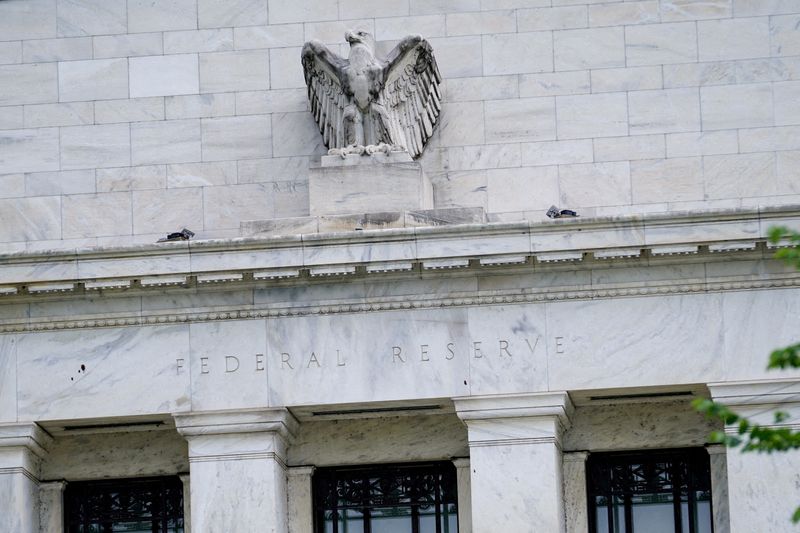By Mike Dolan
LONDON (Reuters) -If you think Federal Reserve interest rate cuts could overly spur an already briskly growing U.S. economy, consider the other side of the equation: the income drag.
A counterintuitive twist on the Fed's unfolding easing cycle is that it should zap cash income from the banking system in the same way it flattered those same deposits when it rapidly hiked rates two years ago.
Given that the latter appears to have blunted the negative effects of higher borrowing costs on the aggregate economy, then the reverse may curtail any economic benefits as rates head down. And it could complicate the U.S. central bank's job considerably if the Goldilocks scenario doesn't play out as planned.
Morgan Stanley strategists have recently crunched the numbers around the income boost that accompanied Fed hikes and the potential drag that could soon be coming, noting that historical models of U.S. central bank policy lags have failed to account for this novel dynamic.
Unlike in decades past, the Fed now pays large amounts of interest to commercial banks for reserves that it holds. These volumes were boosted massively during the central bank's emergency balance sheet expansions after the 2008 banking crash and again after the 2020 COVID-19 pandemic. While excess reserves have declined in the past year, they appear to have settled around $3.1 trillion.
The Fed also offers interest on its daily reverse repo facility in this cycle as a way of siphoning off what it considers to be excess liquidity. The current volume is less than one-fifth of its peak but still running at about $300 billion to $400 billion per night.
And then there are the more traditional interest-bearing short-term assets. About one-third of the more than $6 trillion of money market fund assets is invested in U.S. Treasury bills of one-year or less, which pay interest at rates that move roughly in step with the federal funds rate as they mature and get rolled over - meaning they've been generating attractive income in recent years but are now set to reverse.
There also is almost $4 trillion in bills outstanding owned by other investors.
The Fed's sharp rate hikes of 2022-2023, which lifted the fed funds rate by 5 percentage points, flattered interest income at all these levels, muffling the economy-wide effects from the intended borrowing squeeze. So cutting rates now could, by the same mechanism, act as a drag on market liquidity and cash income even as credit gets cheaper.
"Just as higher payments of interest income may have muted the effect of monetary policy tightening in 2022-2023, lower payments may mute the effect of easing," the Morgan Stanley strategists wrote. "To the extent the Fed had to raise policy rates higher than otherwise to offset this effect, it may have to lower rates more as well."
BACK TO NEAR-ZERO RATES?
To quantify the potential income drag, the Morgan Stanley team calculates the total hit to monthly income if the Fed returns to what it sees as the "neutral" rate around 3% over the next two years.
Their striking conclusion is that the total hit as a share of projected GDP would be roughly equal to when the Fed took rates to the near-zero level in 2020.
That drag could presumably affect everything from bank earnings and lending to corporate cash holdings and wealth effects. Whether it is enough to offset the cut to actual borrowing costs is an open question.
This headwind to Fed easing, however, may well be appropriate for a central bank seeking to gently recalibrate policy to a notional equilibrium, especially given the resilience of the underlying economy.
The drag could even neatly regulate any excessive stimulus, much as Fed tightening was softened by the income boost it generated for many cash-rich companies and relatively wealthy households.
But there could be a serious problem if the U.S. central bank were to struggle to gain traction with rate cuts because of an economic shock or alarming re-emergence of deflationary pressures. The Fed could then find itself easing much more than it currently expects.
The once-distant prospect of a return to a world of near-zero rates may then not be as fanciful as many have come to assume in the post-pandemic era. Speculation that inflation could get too low is already emerging in Switzerland, the euro zone and even China.
This dynamic could also complicate the Fed's so-called "quantitative tightening" plans. With U.S. commercial bank reserves already close to what many assume to be a "steady state" going forward, most money market analysts see the Fed ending its balance sheet rundown next year.

Should the income drag from rate cuts prove problematic, Fed noises about ending the quantitative tightening may get a lot louder.
The opinions expressed here are those of the author, a columnist for Reuters
(by Mike Dolan; Editing by Paul Simao)